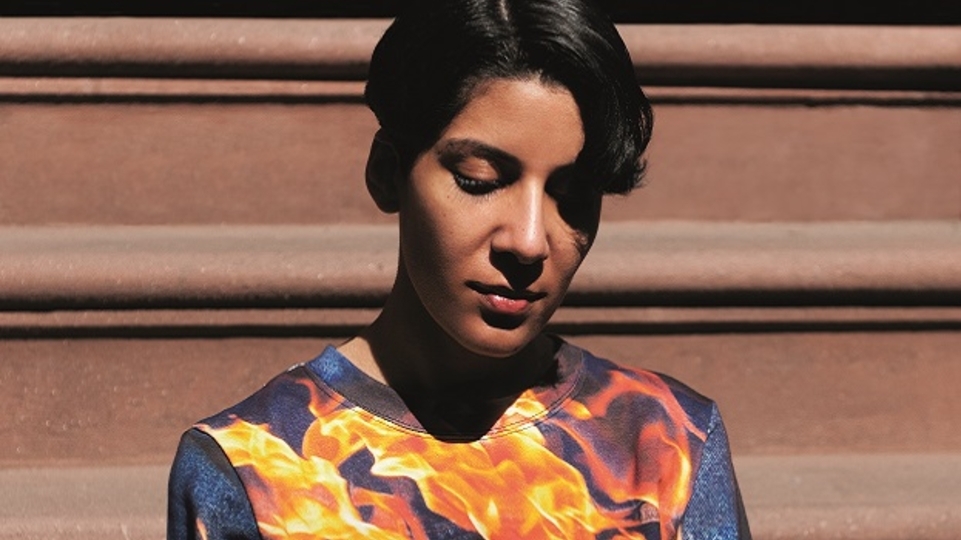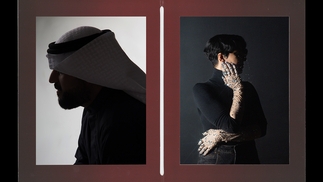EASTERN VISIONS
We catch up Fatima to talk about the theme behind the album, her musical roots, and more...

Fatima Al Qadiri is as difficult to classify as her vast productions. She could simultaneously be deemed a visual artist, academic instigator, journalist (as a frequent contributor to DIS), composer, or fashion-world crossover (recently soundtracking a runway show for KENZO), all in the same breath.
The 32-year-old is best known within electronic music circles, meanwhile, for her staggering ‘Desert Strike’ on Fade To Mind, the aptly titled ‘Genre-Specific Xperience’ on Ono, and her affecting ‘WARN-U’ (released under the moniker Ayshay) on Tri Angle. Each of the three EPs — deeply wrapped with intellectual concepts and heavily thematic structures — made her increasingly fascinating and refreshing, and even more difficult to pin down musically.
Born in Senegal, raised in Kuwait during turbulent times, and now based in NYC, Al Qadiri also works as part of two groups: rousing art collective GCC (Gulf Cooperation Council) and electronic supergroup Future Brown (formed with fellow New Yorkers NGUZUNGUZU and Lit City Trax boss J-Cush). Both collectives have been given the stamp of approval by NYC institution MoMA, amongst many art and music aficionados worldwide.
Set for release on Hyperdub this May, her debut full-length album — ‘Asiatisch' — is truly a world of its own. Building on her concept of an “imagined China,” Al Qadiri boldly explores the landscape of Sino Grime (a sub-genre of grime that revolves around Asian motifs) and recontextualises many deeply embedded stereotypes about the Far East and beyond. After a couple months’ stint in London (spent mixing the album on analogue engineer LEXXX’s SSL desk), Fatima sits from her apartment in NYC to discuss her controversial and mind-opening new work...
When did you start producing?
“I started making music when I was a kid on toy keyboards, and then when I was 19 I got software (Logic) for the first time. So basically from the age of nine to the age of 19, so 10 years, I was composing on different sized keyboards and recording them on cassette. Just for playback purposes.
I still have my first keyboard that I made my first melody on. It’s with me here in my apartment. It’s like the teddy bear that you take around with you, the security blanket! (laughs) It’s very dear to me so I brought it with me.
“There was a keyboard in the house from when I was a baby. I never had music lessons but I would always tinker with it. When I was nine, I made my first piece, or whatever you could call it. (laughs) And I just played it to myself over and over and over again, I still remember it. It’s actually depressing, it’s a very very depressing melody.
It’s really dark. I made it right after the liberation of Kuwait so there’s a context for the darkness. If you know me very intimately then you know there is one element of my personality that’s extremely childlike. And it is this nine-year-old girl that was frozen in 1990.”
What music was played in your house growing up?
“My father was a huge music fan. He had a really varied record collection that he blasted constantly. Whenever we were in the house, the house was not silent. Even when we had to have uncomfortable, awkward conversations — he had three daughters! — he’d say, ‘Wait, let me turn the music on!’ (laughs) He gave me his record collection a few years ago when he completely switched to digital. Suddenly my record collection quadrupled.
I really realised how incredible his collection was — Grace Jones records were a surprise and Pink Floyd, there was lots of disco, too. For some weird reason, he played Cerrone over and over when I was growing up! ‘Supernature’ is one of my earliest musical memories.
“He also had a lot of Arabic classical music and Russian classical music. My parents studied in Moscow in the '70s (they both did grad school there) so he was a huge fan of Russian classical music. His favourites were Rimsky Korsakov and Tchaikovsky. I’m definitely 1000% influenced by Russian classical music, because it’s the most Eastern-sounding in Western classical music.”
What can you tell us about GCC’s exhibition at MoMA?
“It’s called Achievements in Retrospective. It’s basically selected works from our first four exhibitions, all exploring the theme of achievement. GCC is about a lot of things, but one of them is exploring invisible rituals in the Gulf: diplomatic language and Gulf aesthetics.There are nine of us in total, seven from Kuwait, one from Bahrain and one from Qatar. We’ve been working together for years on random projects, and decided to form into an entity. This is the biggest exhibition we’ve ever done because it’s our first in America but it’s also our first at this very prestigious institution.”
And another entity of yours — Future Brown — just did a performance piece at MoMA’s PS1! That project is starting to take off...
“Yes, Future Brown is going really, really well. We’re finishing our first album, it’s going to roll out sometime this fall. It’s exciting for me to be participating in two albums this year. The Future Brown album is all vocal tracks. This is a project about realising our dreams: we have an A4 piece of paper that has our dream vocalists on it.
We want to try to tick as many names off it as possible. The album has a lot of MCs (whether they’re from England or the States or Jamaica or Puerto Rico) and a lot of R&B vocalists. There’s even a reggaeton track with Maluca. This record is not about limitations, it’s really about us doing whatever we want. And identifying a label that can respect that.”

What label will it be released on?
“Ooh, I can’t say! (laughs) That’s being finalised right now.”
How did Future Brown come together?
“I first met Esma [NGUZUNGUZU] in 2008 or 2009 but we didn’t become friends till 2010. I also met Jamie, J-Cush, around 2010. We were all working together separately and we decided to team up. I feel like more heads than one makes you stronger. With Future Brown, we’ve rarely needed to compromise on anything.
The most difficult thing about managing this project is actually managing files. (laughs) There are so many vocalists and so many files, all on different computers, in different studios. We’ve actually lost a whole track because we can’t find the file! And it’s one of my favourite tracks.”
I went to a Chinese restaurant last night with live Chinese music. It was interesting to listen to ‘Asiatisch’ afterwards, and hearing your interpretation and recreation of those traditional sounds, especially considering you’ve never been to China...
“I’m so fascinated with this idea of imagined China. You don’t have to go to China, you can just go to the China that’s been weaved by Western ideas and media for centuries. I feel like a lot of this record is about this dislocation of ideas from their origin. It’s about this imagination of the other.”
What was the catalyst for the album?
“Shanzai Biannial, the artists who made the ‘Asiatisch’ cover, gave me the acapella that became the album’s first track [‘Shanzai’]. They were making a video using this nonsense version of [Prince’s] ‘Nothing Compares 2U’ in Mandarin that they found on YouTube. They got a friend of a friend, this singer Helen Fang, to sing that version. They sent it to me to make a cheap Chinese instrumental to put under it, and I didn’t follow their instructions. (laughs) They didn’t use my version in the end, it didn’t follow their concept. But I still wanted to use it! That’s what really started the record.”
When I first listened to ‘Shanzai,’ it was strangely nostalgic and familiar but I couldn’t place it...
“The thing about this track that really encapsulates the record really well is this feeling: a familiarity but total alienness. Even the title — ‘Nothing Compares 2U’ — it’s comparing one thing to another. And that’s how the West and the East work together: there’s always this game of comparison. I wanted to make this very familiar tune feel alien, and take it completely out of context several times, not just once. The actual lyrics are not the actual lyrics of the original song, even in translation. So it really speaks to this feeling of being at a loss. In general, when people ask me to describe this idea of imagined China, I tell them I’m at a loss because really, it’s centuries’ worth of film and video and comic book and fiction. It’s volumes and volumes, it’s its own encyclopedia. (laughs) It’s all false. It has vestiges of reality in it but it’s all removed from reality.”
What production tools and instruments did you use?
“There’s no analogue on there whatsoever. But, for instance, there’s a preset drum kit with Logic called the Asian Kit and I just used it. That was the point: I wanted to use preset elements. This is about a virtual China, including virtual instruments. The only thing I robotised and scrambled was the poetry. With the three poems that I sampled, one of them is from the oldest anthology of Chinese poetry, it dates back to around 1000 BC. China’s ancient soul is in this poem. I scrambled it and I affected it with pitch shifters and effects, to remove it from being so pure.”

Tell me more about your interest in Sino Grime..
“This record musically — the actual concrete music — is an homage to Sino Grime. The Asian influence is present in rap and it’s present in grime, because it has this martial art rivalry element. It lends itself to music that revolves around outdoing your rival. With Wu Tang and ODB, there are these Asian elements of being about the wisest and physically strongest. They pay their own homages to Bruce Lee and so on. It’s something that reinvigorates generations of musicians, whether they’re conscious of it or not. So hence my homage to Sino Grime, which really is just a collection of tracks from the early 2000s and from the later 2000s that had Asian motifs present in them.
“I named one of the tracks 'Wu Dang', which is the name of a mountainous region with Shaolin temples, after Wu Tang Clan. Because I felt like [Wu Tang] were a major element in — not even defining, but bringing it to people’s consciousness, that this is something really concrete. Also — with grime, one of the biggest inspirations in grime is [popular video game] Street Fighter, which is very quote-unquote Asian. There is a conflation, it does get lost in the mind of the West — this difference between Japan and China. It is conflated and merged into one.”
How did you link up with Hyperdub?
“I hired a manager around September and his first instinct was to send it to Hyperdub. Randomly he sent the demos to Kode as he was landing in China! Kode was very spooked by it, and pretty much immediately decided to put it out. It was actually a cosmic enterprise. From the conception as well. The weirdest thing is that — I think it was on the first or second Hyperdub release, there was a Prince cover, where Hyperdub had to pay mechanical royalties to Prince. So when I brought up the ‘Shanzai’ sample, they were like, ‘Oh yeah, we’ve already done that! We have the form and everything' (laughs). It was just so random. It’s all a perfect fit. Especially considering that Kode9 is the actual person that coined the term 'Sino Grime'! The one thing I really do firmly believe in is destiny, and this was pretty aligned. It’s really exciting.”
Words: Danna Takako
